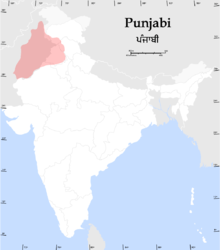Punjabi Suba movement
| Punjabi Suba movement | |||
|---|---|---|---|
|
The East Punjab state in India from 1956 to 1966 | |||
| Date | 15 August 1947 - 1 November 1966 | ||
| Location | East Punjab, India | ||
| Goals | Creation of the separate state of Punjab for Punjabi-speaking people from the bilingual East Punjab state | ||
| Methods | Protest march, Street protest, Riot, Hunger strike, General strike | ||
| Result | Formation of Punjab and Haryana states as well as the Union Territory of Chandigarh on 1 November 1966. Transfer of hill regions to Himachal Pradesh. | ||
| Parties to the civil conflict | |||
| |||
| Lead figures | |||
|
| |||
The Punjabi Suba movement aimed at creation of a Punjabi-majority subah ("province") in the erstwhile East Punjab state of India in the 1950s. Led by the Akali Dal, it resulted in the formation of the Punjabi-majority Punjab state, the Hindi-majority Haryana state and the Union Territory of Chandigarh. Some Pahari majority parts of the East Punjab were also merged with Himachal Pradesh as a result of the movement.
Background

In the 1950s, the linguistic groups across India sought statehood, which led to the establishment of the States Reorganisation Commission in dec 1953. At that time, the Punjab state of India included present-day states of Punjab, Haryana and Himachal Pradesh (some parts) along with Chandigarh. The vast majority of the Sikhs lived in this Hindu-majority Punjab.
The Akali Dal, a Sikh-dominated political party active mainly in Punjab, sought to create a Punjabi Suba ("Punjabi Province"). The Sikh leaders such Fateh Singh tactically stressed the linguistic basis of the demand, while downplaying its religious basis — a state where the distinct Sikh identity could be preserved.[1]
The Government of India was wary of carving out a separate Punjabi language state, because it effectively meant dividing the state along religious lines: Sikhs would form a 60% majority in the resulting Punjabi state.[2] Fresh from the memory of the violent religion-based partition of India in 1947, the Punjabi Hindus were also concerned about living in a Sikh-majority state. The Hindu newspapers from Jalandhar, exhorted the Punjabi Hindus to declare Hindi as their "mother tongue", so that the Punjabi Suba proponents could be deprived of the argument that their demand was solely linguistic. This later created a rift between Hindus and Sikhs of Punjab. The case for creating a Punjabi Suba was presented to the States Reorganisation Commission. The States Reorganisation Commission, not recognising Punjabi as a language that was grammatically very distinct from Hindi, rejected the demand for a Punjabi-majority state. Another reason that the Commission gave in its report was that the movement lacked general support of the people inhabiting the region.
According to the States Reorganisation Act, the Patiala and East Punjab States Union (PEPSU) was merged with Punjab. However, the state still did not have a clear Punjabi majority, as it contained a large Hindi-speaking area.
Akali Dal's agitation
The Akali Dal leaders continued their agitation for the creation of a "Punjabi Suba" after the merger of PEPSU to Punjab. The Akal Takht played a vital role in organising Sikhs to campaign for the cause. During the Punjabi Suba movement, 12000 Sikhs were arrested for their peaceful demonstrations in 1955 and 26000 in 1960-61.
Result
In September 1966, the Indira Gandhi-led Union Government accepted the demand, and Punjab was trifurcated as per the Punjab Reorganisation Act.[3]
Areas in the south of Punjab that spoke the Haryanvi dialect of Hindi formed the new state of Haryana, while the areas that spoke the Pahari dialects were merged to Himachal Pradesh (a Union Territory at the time). The remaining areas, except Chandigarh, formed the new Punjabi-majority state, which retained the name of Punjab.[4] Until 1966, Punjab was a Hindu majority state (63.7%). But during the linguistic partition, the Hindu-majority districts were removed from the state.[5] Chandigarh, the planned city built to replace Punjab's pre-partition capital Lahore, was claimed by both Haryana and Punjab. Pending resolution of the dispute, it was declared as a separate Union Territory which would serve as the capital of both the states. But still some Sikh organisations hold the view that trifurcation was not properly carried out, as many Punjabi speaking districts went to Haryana, since Haryana has second largest Punjabi speaking population of India & many of its districts are Punjabi dominated or have large minorities.
Leaders
The prominent leaders of the movement included:
References
- ↑ Brass, Paul R. (2005). Language, Religion and Politics in North India. iUniverse. p. 326. ISBN 978-0-595-34394-2.
- ↑ "Hindu-Sikh relations — I". The Tribune. Chandigarh, India: Tribuneindia.com. 2003-11-03. Retrieved 2010-01-11.
- ↑ "The Punjab Reorganisation Act, 1966" (PDF). Government of India. 1966-09-18. Retrieved 2011-12-26.
- ↑ The Sikhs: History, Religion, and Society By W. H. McLeod,Published 1991, Columbia University Press
- ↑ The Sikhs as a "Minority" in a Sikh Majority State in India, by Paul Wallace, Asian Survey, 1986 University of California Press
Coordinates: 31°00′N 76°00′E / 31.000°N 76.000°E
.png)
